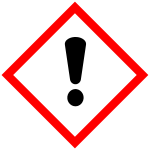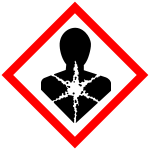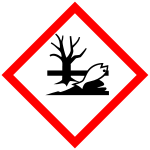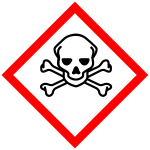Notified classification and labelling according to CLP criteria
General Section
EC / List no.

|
Name |
CAS Number

|
Additional Notified Information

|
|---|---|---|---|
| 202-486-1 | 1,2,3-trichloropropane | 96-18-4 |
State/Form
|
| Classification | Labelling | Specific Concentration limits, M-Factors | Notes |
Classification affected by Impurities / Additives

|
||
|---|---|---|---|---|---|---|
| Hazard Class and Category Code(s) | Hazard Statement Code(s) | Hazard Statement Code(s) | Supplementary Hazard Statement Code(s) | |||
| Acute Tox. 3 | H301 |
Note D
|
||||
| H301+H311 | ||||||
| Acute Tox. 3 | H311 | |||||
| Eye Irrit. 2 | H319 | H319 | ||||
| Acute Tox. 3 | H331 | |||||
| Muta. 2 | H341 | H341 | ||||
| Carc. 1B | H350 | H350 | ||||
| Repr. 1B | H360 | H360 | ||||
| STOT RE 1 | H372 (Causes damage t...) (inhalation) | H372 (Causes damage t...) | ||||
| STOT RE 2 | H373 (May cause damag...) (dermal) | H373 (May cause damag...) | ||||
| STOT RE 2 | H373 (May cause damag...) (oral) | H373 (May cause damag...) | ||||
| Aquatic Chronic 2 | H411 | |||||
| Signal Words | Pictograms | ||||||||||||
|---|---|---|---|---|---|---|---|---|---|---|---|---|---|
| Danger |
|
Detailed Information on classification and labelling
Classification
| Physical and Chemical hazards | |||
|---|---|---|---|
| Hazard Category | Hazard Statement |
Reason for no Classification

|
|
| Explosives | data conclusive but not sufficient for classification | ||
| Flammable Gases and Chemically Unstable Gases | data conclusive but not sufficient for classification | ||
| Flammable Aerosols | data conclusive but not sufficient for classification | ||
| Oxidising Gases | data conclusive but not sufficient for classification | ||
| Gases Under Pressure | data conclusive but not sufficient for classification | ||
| Flammable Liquids | data conclusive but not sufficient for classification | ||
| Flammable Solids | data conclusive but not sufficient for classification | ||
| Self-reactive Substances and Mixtures | data conclusive but not sufficient for classification | ||
| Pyrophoric Liquids | data conclusive but not sufficient for classification | ||
| Pyrophoric Solids | data conclusive but not sufficient for classification | ||
| Self-heating Substances and Mixtures | data conclusive but not sufficient for classification | ||
| Substances and Mixtures which in contact with water emit flammable gases | data conclusive but not sufficient for classification | ||
| Oxidising Liquids | data conclusive but not sufficient for classification | ||
| Oxidising Solids | data conclusive but not sufficient for classification | ||
| Organic Peroxides | data conclusive but not sufficient for classification | ||
| Substances and Mixtures corrosive to Metals | data conclusive but not sufficient for classification | ||
| Desensitized Explosives | Data lacking | ||
| Human Health hazards | |||
| Hazard Category | Hazard Statement |
Reason for no Classification

|
|
| Acute Toxicity - Oral | Acute Tox. 3 | H301 | |
| Acute Toxicity - Dermal | Acute Tox. 3 | H311 | |
| Acute Toxicity - Inhalation | Acute Tox. 3 | H331 | |
| Skin Corrosion / Irritation | data conclusive but not sufficient for classification | ||
| Serious Eye Damage / Eye Irritation | Eye Irrit. 2 | H319 | |
| Respiratory Sensitisation | data lacking | ||
| Skin Sensitisation | data conclusive but not sufficient for classification | ||
| Aspiration Hazard | data lacking | ||
| Germ Cell Mutagenicity | Hazard Category | Hazard Statement |
Reason for no Classification

|
| Germ Cell Mutagenicity | Muta. 2 | H341 | |
| Carcinogenicity | Hazard Category | Hazard Statement |
Reason for no Classification

|
| Carcinogenicity | Carc. 1B | H350 | |
| Reproductive Toxicity | Hazard Category | Hazard Statement |
Reason for no Classification

|
| Reproductive Toxicity | Repr. 1B | H360 | |
| Effects on or via Lactation | data lacking | ||
| Specific target organ toxicity - Single | Hazard Category | Hazard Statement |
Reason for no Classification

|
| Specific target organ toxicity - Single | data conclusive but not sufficient for classification | ||
| Specific target organ toxicity - Repeated | Hazard Category | Hazard Statement |
Reason for no Classification

|
| Specific target organ toxicity - Repeated | STOT RE 2 | H373 | |
| Affected Organs | May cause damage to liver and kidneys through prolonged or repeated exposure via the oral route | ||
| Route of exposure | oral | ||
| Specific target organ toxicity - Repeated | STOT RE 2 | H373 | |
| Affected Organs | May cause damage to liver and kidneys through prolonged or repeated exposure via dermal route | ||
| Route of exposure | dermal | ||
| Specific target organ toxicity - Repeated | STOT RE 1 | H372 | |
| Affected Organs | Causes damage to nasal tissues, liver and kidneys through prolonged or repeated exposure via inhalative route | ||
| Route of exposure | inhalation | ||
| Environmental Hazards | |||
| Hazardous to the aquatic environment | Hazard Category | Hazard Statement |
Reason for no Classification

|
| Hazardous to the aquatic environment - acute | data lacking | ||
| Hazardous to the aquatic environment - chronic | Aquatic Chronic 2 | H411 | |
| Hazardous to the atmospheric environment | Hazard Category | Hazard Statement |
Reason for no Classification

|
| Hazardous to the ozone layer | data lacking | ||
| Additional Hazard Classes | Additional Hazard Statements |
|---|---|
| No available Data | |
Labelling
| Hazard Statement Code(s) | Phrase | Additional Text |
|---|---|---|
| H319 | Causes serious eye irritation. | |
| H341 | Suspected of causing genetic defects |
|
| H350 | May cause cancer |
|
| H360 | May damage fertility or the unborn child |
|
| H372 | Causes damage to organs |
Causes damage to nasal tissues, liver and kidneys through prolonged or repeated exposure via inhalative route |
| H373 | May cause damage to organs |
May cause damage to liver and kidneys through prolonged or repeated exposure via the oral or the dermal route |
| H301+H311 | H301+H311: Toxic if swallowed or in contact with skin. |
| Note Title | Note Text |
|---|---|
| Note D | Certain substances which are susceptible to spontaneous polymerisation or decomposition are generally placed on the market in a stabilised form. It is in this form that they are listed in Part 3. , However, such substances are sometimes placed on the market in a non-stabilised form. In this case, the supplier must state on the label the name of the substance followed by the words "non-stabilised". |



